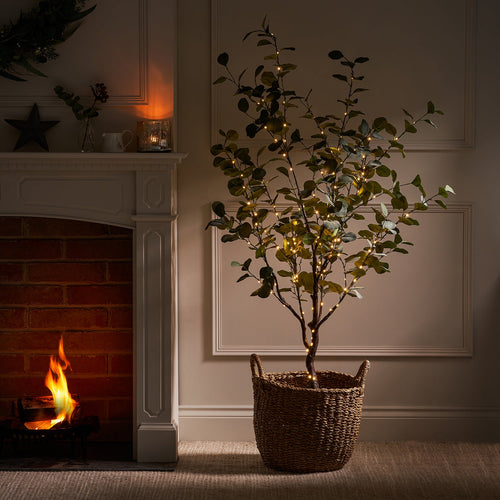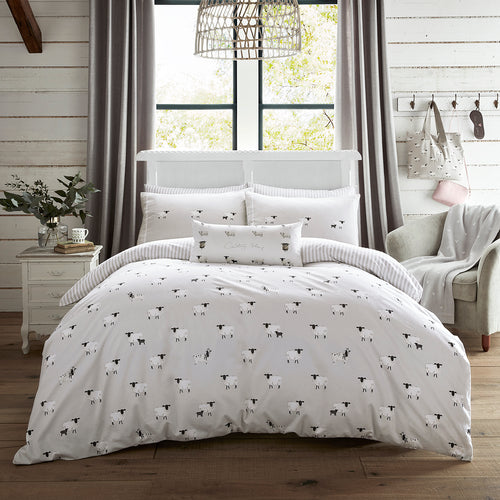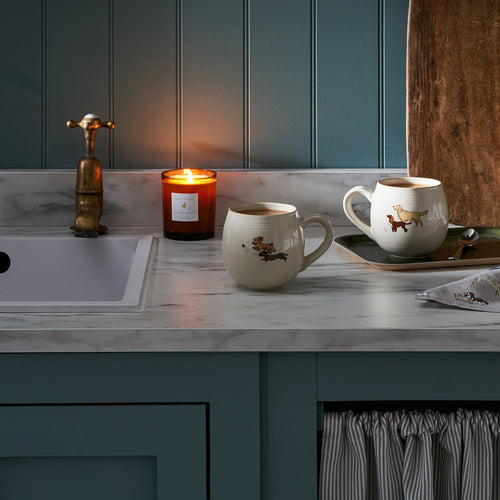Not all surfaces are equal. Here we will guide you through how best to prepare each surface, which paint finish is most suitable, and what techniques to use.
Choosing the Right Paint for Different Surfaces
The first step is to understand the difference between Matt and Eggshell Emulsion.
Matt emulsion is ideal for interior walls and ceilings. It offers great coverage and depth of cover, and is especially good at camouflaging small wall bumps, cracks, or other imperfections, as this finish does not reflect light.
Eggshell emulsion has a slight sheen and is somewhat more durable, so works well on woodwork and metalwork around the home. This should be your go-to for kitchen cupboards, radiators, skirting boards, doors, and furniture.
Essential Tools and Materials for Paint & Decorating
We recommend the following:
- Stepladder
- Roller, roller sleeve, and paint tray
- Mini-roller, foam roller sleeve and paint tray
- 1” or 2” paint brush
- Decorating tape
- Paint stirrer
Quality brushes will make your job easier and will give you a more professional finish.
- Look for tightly packed bristles through the ferrule (the metal part at the base of the handle) that spring back when you bend them.
- Those that taper at the ends will offer a smoother finish.
- Opt for synthetic bristles for use with our water-based paints.
As for rollers, you need to consider their size, pile, and material.
- We recommend at least a 9” roller for large surface areas such as walls and ceilings.
- Short pile rollers are better suited for most interior walls, as they will leave a smoother finish. A roller with a thick pile on the other hand is better for textured surfaces, as the pile can get in all the nooks and crannies for better coverage.
- When it comes to material, it all depends on the finish you were after. A microfibre paint roller delivers a smoother finish, while a lambswool paint roller adds more texture.
Safety Equipment and Practices For Painting
We’re proud to say that our luxury water-based paint is low in volatile organic compounds (VOC) and is certified A+ for Indoor Air Quality. So, you can paint to your heart's content, knowing you and your family are safe from harmful toxins.
You don’t need strong chemicals to clean your brushes and rollers either. Immediately after use, wash your brush or roller with soap or mild detergent and warm water. Repeat the process if necessary.
If you have any paint left over at the end of your project, we advise you to contact your local household waste recycling centre to check if they accept paint. If they don’t, dry out your paint by adding sawdust, cat litter, or soil to the tin. After a few days, the paint should have dried out and can be disposed of in your household waste.
Can You Paint Over Wallpaper?
Yes, you can paint over wallpaper. However, as with any painting, the key is to prepare the surface correctly.
- Ensure the wallpaper is clean by gently wiping it with sugar soap (being careful not to make the surface too wet and damage the wallpaper). Check that no corners are peeling up - glue down any areas where the wallpaper is starting to lift.
- To prevent peeling after painting wallpaper, use clear caulk. Seal the edges at the top and bottom by applying a thin line where the wallpaper and ceiling/floor meet.
- Paint the wallpaper with an oil-based primer. Our water-based paint will absorb into the paper, so you will need to create a barrier between the two.
And now you’re ready to paint!
Can You Paint Over Gloss?
Yes, just follow these simple steps.
- Use sugar soap and a clean sponge to wash the surface. Then use water and a clean cloth to wash off any residue. Let it dry.
- Sand and prime. Lightly sand the area to create a rough texture on the surface. Follow with a primer. Both steps will ensure you have created the best base for the paint to adhere to and will give you a more durable finish.
- Paint!
Can You Paint Over Varnish?
Yes, you can paint over varnished wood
- Clean the surface to remove dirt and grease.
- Lightly sand the area to create a rough texture and wipe away any dust. Follow with a specialist wood primer, which will provide the perfect base for your paint.
- Finish with your desired paint colour. We recommend using eggshell emulsion for a durable finish.
Can You Paint Over Plaster?
Yes, you can paint over plasterboard.
- Allow the plaster to dry thoroughly.
- Dilute your Sophie Allport paint with 10% water to create a 'mist coat' and apply it to the walls. The mist coat will act as a primer and seal the surface.
- Paint your walls as normal.
Can You Paint Over Decorators Caulk?
It depends on the formulation.
Acrylic caulk for example has been designed for use on woodwork such as skirting boards thanks to their ability to be painted.
However, silicone caulks are fully waterproof, which is why they are ideal for use in kitchens and bathrooms and cannot be painted.
Can You Paint Over Metal?
Of course! If you're thinking of painting over radiators or metal furniture, follow these easy steps:
- To ensure the paint will stick, sand before wiping away any dust with a damp cloth.
- Use a primer specifically for metal to provide the perfect base for your paint.
- Finish with your desired paint colour. We advise using an eggshell finish as it is slightly more durable and will adhere better to the metal surface.
Application Techniques
Eggshell Painting Techniques
Eggshell paint can be applied by brush, roller, or spray. For best results, prepare wooden surfaces and furniture by lightly sanding before applying a specialist primer. We recommend finishing with two full coats of eggshell paint.
Matt Emulsion Painting Techniques
Matt Emulsion is perfect for hiding imperfections, thanks to its low reflective value. Use on walls and ceilings with either a roller or paintbrush. Avoid brush or roller marks on walls by ensuring your brush or roller maintains a wet edge, use moderate pressure, and wait at least two hours in between coats. Our paint offers fantastic coverage, but we’d still recommend using two coats for an optimum finish.
Now you’ve got your newly decorated room, why not explore our home décor pieces to perfectly complement your room refresh?












